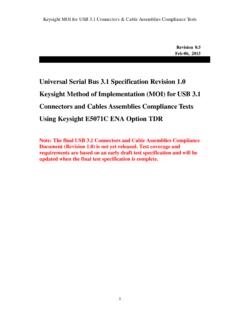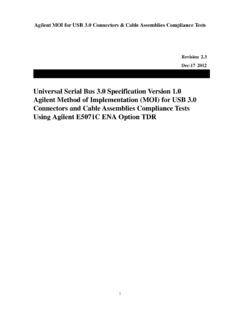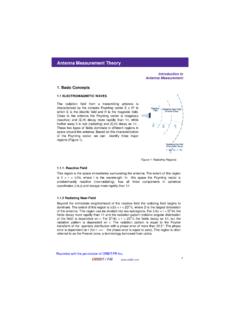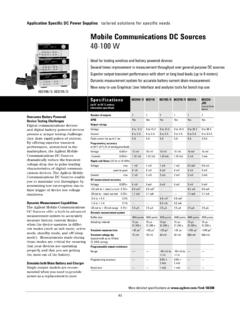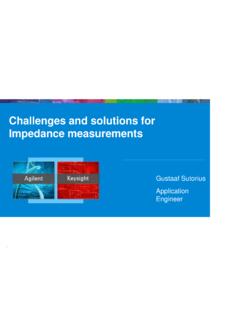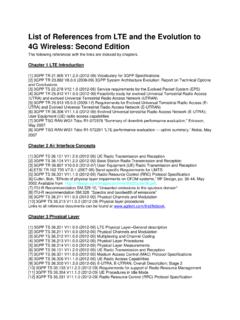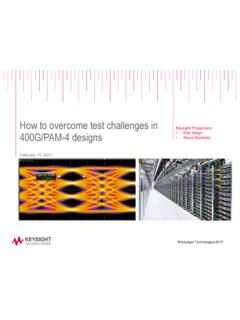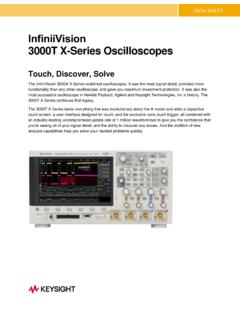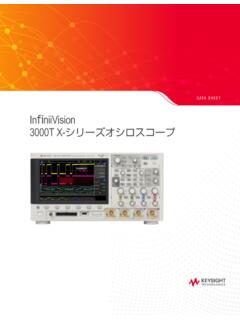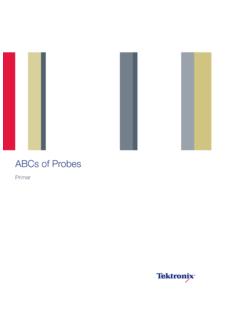Transcription of N2791A 25 MHz and N2891A 70 MHz High-Voltage …
1 N2791A 25 MHz and N2891A 70 MHz High-Voltage differential ProbesUser s GuideFor Safety, Regulatory, and publishing information, see the pages at the back of this book. Copyright Agilent Technologies 2009 All Rights Reserved. 2 ContentsInspecting the Probe 3 Cleaning the Probe 3 Handling the Probe 3N2791A/ N2891A High-Voltage differential probes 4 Contents and Accessory Kits 5 Characteristics and Specifications 7 Safety Information 9 Using the N2791A High-Voltage differential Probe 10 Using the N2891A High-Voltage differential Probe 11N2791A Plots 12N2891A Plots 16 Using the Accessories 20 3 Inspecting the ProbeInspecting the ProbeoInspect the shipping container for damage. Keep the damaged shipping container or cushioning material until the contents of the shipment have been checked for completeness and the probe has been checked mechanically and electrically.
2 OCheck the accessories. If the contents are incomplete or damaged, notify your Agilent Technologies Sales Office. oInspect the instrument. If there is mechanical damage or defect, or if the probe does not operate properly or pass calibration tests, notify your Agilent Technologies Sales Office. If the shipping container is damaged, or the cushioning materials show signs of stress, no ti f y th e c a rri e r as we ll a s yo ur A gi l en t Technologies Sales Office. Keep the shipping materials for the carrier s inspection. The Agilent Technologies office will arrange for repair or replacement at Agilent Technologies option without waiting for claim the ProbeDisconnect the probe and clean it with a soft cloth.
3 Make sure the probe is completely dry before reconnecting it to an oscilloscope. Avoid using abrasive cleaners and chemicals containing benzene or similar the ProbeHandle the probe with care and refer to the safety notices at the back of this manual and on page 9. Note that the probe cable is a sensitive part of the probe and, therefore, you should be careful not to damage it through excessive bending or pulling. You should also avoid any mechanical shocks to this product in order to guarantee accurate performance and protection.! 4N2791A/ N2891A High-Voltage differential ProbesN2791A/ N2891A High-Voltage differential ProbesThe N2791A / N2891A High-Voltage differential probes allow conventional earth-grounded oscilloscopes to be used for floating signal measurements (up to 700 V of differential or common mode voltage for the N2791A and up to 7000 V of differential or common mode voltage for the N2891A ).
4 The N2791A offers users selectable attenuation settings of 10:1 and 100:1 while the N2891A offers attenuation settings of 100:1 and 1000:1, making both probes highly versatile and usable for a broad range of applications including power supply measurements and motor controls. Both probes are compatible with any oscilloscope with a 1 MW BNC input. The probes can be powered by any USB port on an oscilloscope or computer, or by internal batteries (4x AA included with the probe).The images below show some key parts of the N2891A probe body. The N2791A has similar switches/LEDs, but they are arranged differently. Battery Use Insert 4 AA batteries in the back of the unit as indicated within the chassis (see pages 10-11 for information on accessing the battery location)
5 When battery life has expired, remove the batteries When the batteries gets close to running out, the power indicator will start to flicker and dim Note the WEEE label on the batteries and dispose of properly on/off switchpower LED indicatorattenuationswitchUSB powercord inputoverrangeindicator 5 Contents and Accessory KitsContents and Accessory KitsThe following table lists the parts included with the N2791A High-Voltage differential N2791A replacement accessories, you can order the N2791-68700 differential Probe Accessory Kit. It includes:TPartQuantityN2791A 25 MHz differential probe1 Safety Hook, Red1 Safety Hook, Black1 Alligator Clip, Red1 Alligator Clip, Black1 USB Power Cord (2 m)1AA Battery4 User s Guide1 PartQuantitySafety Hook, Red1 Safety Hook, Black1 Alligator Clip, Red1 Alligator Clip, Black1 USB Power Cord (2 m)1 6 Contents and Accessory KitsThe following table lists the parts included with the N2891A High-Voltage differential N2891A replacement accessories, you can order the N2891-68700 differential Probe Accessory Kit.
6 It includes:PartQuantityN2891A 70 MHz differential probe1 Safety Hook, Red1 Safety Hook, Black1 high voltage Alligator Clip, Red1 high voltage Alligator Clip, Black1 USB Power Cord (2 m)1AA Battery4 User s Guide1 PartQuantitySafety Hook, Red1 Safety Hook, Black1 high voltage Alligator Clip, Red1 high voltage Alligator Clip, Black1 USB Power Cord (2 m)1 7 Characteristics and SpecificationsCharacteristics and SpecificationsCharacteristics and specifications for the N2791A and N2891A High-Voltage differential probes are shown below. The probe / oscilloscope should be warmed up for at least 20 minutes before any testing and the environmental conditions should not exceed the probe s specified Characteristics N2791AN2891 ABandwidth (-3 dB)>25 MHz (driving 1 MW oscilloscope input) 70 MHz (driving 1 MW oscilloscope input)Attenuation ratio10:1, 100:1 (switchable)100:1, 1000:1 (switchable)Probe Risetime (10%-90%)14 ns5 nsAbsolute Maximum Rated Input voltage (each side to ground)1000 Vrms CAT II5000 Vrms CAT IMaximum differential Input voltage (DC + AC Peak)\70 V at 10:1 attenuation \700 V at 100:1 attenuation\700 V at 100:1 attenuation \7000 V at 1000:1 attenuationMaximum Common Mode Input voltage \70 V at 10.
7 1 attenuation \700 V at 100:1 attenuation\7000 V at 10:1 attenuation \7000 V at 1000:1 attenuationInput Impedance 4 MW, 10 pF (each side to ground) 8 MW, 8 pF (between inputs)50 MW, 7 pF (each side to ground) 100 MW, 5 pF (between inputs)Output voltage Swing\7 V (driving 1 MW oscilloscope input)\7 V (driving 1 MW oscilloscope input)Offset (typical)\ mV\5 mVCMRR (typical)-80 dB at 60 Hz, -40 dB at 1 MHz-80 dB at 50 Hz, -60 dB at 20 kHzPower Requirements4 AA batteries or USB power adapter (5 V/200 mA, 9 V/120 mA)4 AA batteries or USB power adapter (5 V/200 mA, 9 V/120 mA)Battery Life15 hours (alkaline battery) hours (alkaline battery)Battery/Power Cord The supplied voltage must be less than 12 V and greater than V or else the probe could be damagedThe supplied voltage must be less than 12 V and greater than V or else the probe could be damaged- all are typical 8 Characteristics and SpecificationsMechanical Characteristics Environmental Specifications (same for both N2791A and N2891A )Safety SpecificationsN2791AN2891 AWeight (probe only) 400 g (probe and PVC jacket)500 g BNC Cable Length 95 cm (37 inches)90 cm (35 inches)Length of Input Leads45 cm (18 inches)60 cm (24inches)Dimensions (L x W x H)170 mm x 63 mm x 21 mm ( inches x inches x inches)202 mm x 83 mm x 38 mm ( inches x inches x inches)
8 Temperature Operating: -10 C to +40 CNonoperating: -30 C to +70 CAltitude Operating: 3,000 mNonoperating: 15,300 mHumidityOperating: 25 - 85% room humidity Nonoperating: 25 - 85% room humidity Pollution DegreePollution Degree 2 CEI/IEC 61010-031 CAT II ( N2791A )CEI/IEC 61010-031 CAT I ( N2891A ) 9 Safety InformationSafety InformationWarningTo avoid personal injury and to prevent fire or damage to this product or products connected to it, review and comply with the following safety precautions. Be aware that if you use this probe assembly in a manner not specified, the protection this product provides may be impaired. Observe Maximum Working voltage To avoid injury, do not use the N2791A probe above 1000 Vrms CAT II (both 10:1 and 100:1 attenuation settings) between each input lead and earth or between the two input leads.
9 Do not use the N2891A probe above 5000 Vrms CAT I (1000:1 attenuation) or 500 Vrms CAT I (100:1 attenuation) between the two input leads. Do not use the N2891A probe above 5000 Vrms CAT I (both 100:1 and 1000:1 attenuation settings) between each input lead and earth. Must be Grounded Before making connections to the input leads of this probe, ensure that the output BNC connector is attached to the BNC channel input of the oscilloscope and the oscilloscope is properly grounded. Use Fused Test Prods if Necessary If this probe is intended to be used with circuits of installation category II, it should incorporate the fused test prods. Do Not Operate Without Covers To avoid electrical shock or fire hazard, do not operate this probe with the covers removed.
10 Do Not Operate in Wet / Damp Conditions To avoid electrical shock, do not operate this probe in wet or damp conditions. Do Not Operate in an Explosive Atmosphere To avoid injury or fire hazard, do not operate this probe in an explosive atmosphere. Avoid Exposed Circuit To avoid injury, remove jewelry such as rings, watches, and other metallic objects. Do not touch exposed connections and components when power is Proper Power Source To ensure this probe functions well, use four AA batteries or the supplied USB power Indoor Use Only Only use this probe indoors. ! 10 Using the N2791A High-Voltage differential ProbeDo Not Operate With Suspected Failures If you suspect there is damage to this probe, have it inspected by a qualified service personnel.
